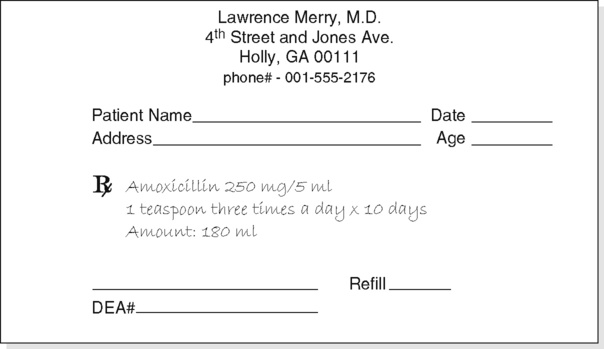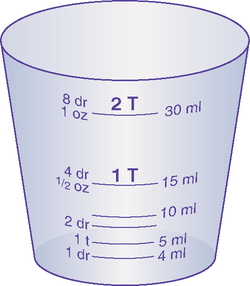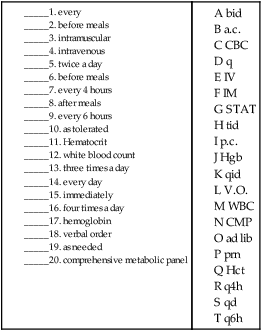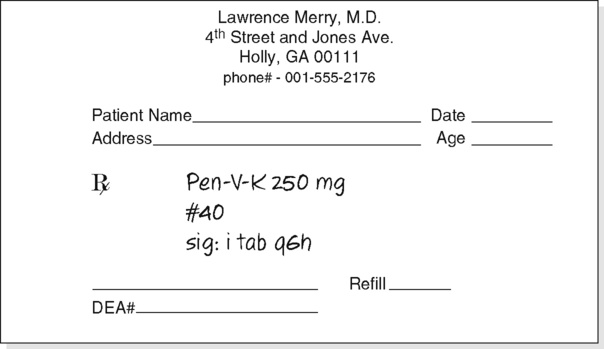Upon completion of this chapter, the learner will be able to: 1. Define the key terms that relate to the chapter. 2. Identify common abbreviations used in the health care field. 3. Interpret basic physician’s orders. 4. Use the appropriate equivalents to solve conversion problems using the metric, apothecary, and U.S. Customary (household measurements) systems. 5. Convert temperature measurements between Fahrenheit and Celsius. Have you ever read the label on a pill bottle after a prescription has been filled? Many times, you will see a mixture of metric and U.S. Customary (household) measurements (Figure 9-1). Then the pharmacist hands you a measuring device with both metric and U.S. Customary (household) measurements on it (Figure 9-2). You want to give or take the correct dose, but which do you use—milliliters or teaspoons? Tables 9-1 and 9-2 identify common abbreviations that are used when giving orders in the health care field. It is important that all health care professionals understand and can interpret common abbreviations—these abbreviations are not exclusive to the study of pharmacology. TABLE 9-1 Abbreviations Commonly Used by Pharmacology and Nursing Health Care Workers TABLE 9-2 Abbreviations Commonly Used by Laboratory and Nursing Health Care Workers Example: Unasyn 500 mg IV Q8H × 3 days Example: CBC q6h × 3 days then D/C. Interpretation: Draw blood for a complete blood count every 6 hours for 3 days, then discontinue. All physician’s orders should have the same basic information—what is to be done and how often. Medication orders and prescriptions must include specific information (Figure 9-3): Let’s look at the prescription in Figure 9-3 and identify the required information.
Application of Measurement and Dose Conversion
Objective 1
Objective 2
Common abbreviations used in the health care field
Abbreviation
Meaning
a.c.
Before meals
Ad lib
As desired
a.m.
Morning
bid
Twice a day
BP
Blood pressure
c¯
With
d
Day
d/c
Discontinue
H, hr
Hour
hs
Hour of sleep
IM
Intramuscular
IV
Intravenous
K
Potassium
Na
Sodium
npo
Nothing by mouth
pc
After meals
p.m.
Afternoon
PO
Per oral or by mouth
prn
As needed
Q, q
Every
qid
Four times a day
qs
Quantity sufficient

Prescription
s¯
Without
SC, SQ, Subq
Subcutaneous
Sig
Directions
SL
Sublingual, under the tongue
STAT
Immediately
Tab
Tablet
tid
Three times a day
TPR
Temperature, pulse, respiration
VO
Verbal order
VS
Vital signs
Abbreviation
Meaning
BM
Bowel movement
CBC
Complete blood count
CMP
Comprehensive metabolic panel
FBS
Fasting blood sugar
Hct
Hematocrit
Hgb
Hemoglobin
H/H
Hemoglobin and hematocrit
Plat.
Platelets
WBC
White blood count
Objective 3
Interpretation of physician’s orders
1. Name of the medication
Inscription
2. Dosage strength of the medication
Inscription
3. How the medication should be taken
Route
4. How often the medication should be taken
Frequency or Signa (Sig)
5. How much medication should be dispensed
Quantity
6. How many refills of the medication are allowed
1. Name of the medication
Pen-V-K (correct name: Pen-Vee K)
2. Dosage strength of the medication
250 mg
3. How the medication should be taken
Tablets (by mouth) route
4. How often the medication should be taken
Every 6 hours
5. How much medication should be dispensed
40 tablets
6. How many refills of the medication are allowed
Refills are not specified so there would be no refills
Application of Measurement and Dose Conversion
Get Clinical Tree app for offline access



 Practice the Skill 9-1
Practice the Skill 9-1

 MATH ETIQUETTE 9-1
MATH ETIQUETTE 9-1 PRACTICE THE SKILL 9-2
PRACTICE THE SKILL 9-2

